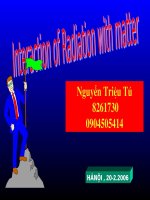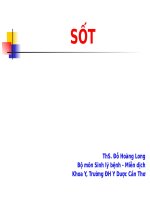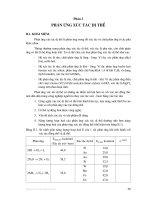Bai giang ve tuong tac
Bạn đang xem bản rút gọn của tài liệu. Xem và tải ngay bản đầy đủ của tài liệu tại đây (5.14 MB, 90 trang )
Ngun TriƯu Tó
8261730
0904505414
Hµnéi , 20-2.2006
1
M.Planck
Einstein
N.Bohr
M.Curie
2
Radius of observable universe
15000.000.000.light -years
Radius of Earth
cell
Atom
Atomic nucleus
3
Energy
Wide Range of Radiation
Energy and Intensity
GeV
Accelerator,
Cosmic rays
MeV
Industrial
application
Medical
diagnosis
Environment
1
102
104
Processing
Radioisotopes
keV
10-2
Medical
treatment
106
108
1010
1012
1014
4
Intensity(s-1)
Concentration
Bq/g
Dose(nGy/h))
interaction of particles and radiation with matter
The measurement of nuclear radiation is based on its
interaction with the detector.
In order to understand:
1* The function of nuclear radiation detectors
2* The absorption phenomena in
the measurement of the radiation
3* With respect to radiation protection.
We shall deal with the most important mechanisms of the interaction
between nuclear radiation and matter in their basic features.
5
To organize the discussions that
follow, it is convenient to arrange
the four major categories of
radiations into the following matrix:
Charged Particulate Radiations
Heavy charged particles
(characteristic distance ≅10-5m)
Fast electrons
(characteristic distance ≅10-3m)
Uncharged Radiations
Neutrons
(characteristic length ≅10-1m)
X-rays and γ rays
(characteristic length ≅10-1m)
6
Mảnh giấy
Lá nhôm
Tấm chì
7
Interaction of particles and radiation with matter
•
Ionization Losses Due to Collisions of Charged Particles Stopping power
•
Bohr's Formula for Specific Ionization. Relativistic Effects
and the Density Effect
• Dependence of ionization Losses on the Medium
•
ionization Losses on the Medium
. Radiation Losses for Electrons.
. Cherenkov Radiation
. n and γ -radiation Interaction with matter
8
Interaction of Gamma Radiation with Matter
1. Photoelectriceffect
2 . Compton scattering
3. Electron-positron Pair
production
9
Photoelectric
effect
M
γ-ray
e-
K
Photoelectric effect
L
ek
A.E
X
A.E :Auger electron
X-ray
K
L
M
hν
Te = Eγ - Ii
Photoelectric effect cannot take place for a free electron (not associated
with an atom).
10
11
The law of conservation of energy:
1
Eγ = me c
− 1
1− β 2
2
The law of conservation of momentum :
(
Eγ / c = me βc / 1 − β 2
)
2
2
2
2
E γ / m e c = 1 / 1 − β − 1 = β / 1 − β or ( − β )/ 1 − β = 1
1
(1 — β)2 = 1 — β2
β = 0 and β = 1
Photoelectric effect is therefore possible only for bound
electrons.
12
the photoelectric effect cross section
1/ With decreasing Eγ (increasing ratio of the electron binding to the
photon energy IK/Eγ ), the cross section increases first as 1/E γ , and later
(as Eγ approaches Ik) more rapidly as 1/ Eγ 7/2 .
2/ The probability of photoeffect depends very strongly on the charge
Z of the atom in which the effect is observed: σ phot ∝ Z5.
σphot ∝ Z5/Eγ
σphot ∝ Z5/Eγ7/2
for
for
Eγ >> IK,
Eγ > IK.
* Photoeffect is especially signifficant for heavy materials where
the probability is considerable even for high energies of γ-quanta.
* In light materials, this effect becomes significant only for relatively
low energies of γ-quanta.
13
In Compton scattering the incoming gamma-ray photon is
deflect through an angle θ with respect to its original
direction. The photon transfers a portion of its energy to
the electron (assumed to be initially at rest), which is
then known as a recoil electron.
hν ’
incoming γ -ray
scattered γ -ray
θ
ϕ
hν
(Free electron)
Ee −
( recoil electron).
14
hν ’
hν
scattered γ
-ray
θ
ϕ
incoming γ -ray
Free electron
Ee −
recoil electron.
Because all angles of scattering are possible, the
energy transferred to the electron can vary from zero to
a large fraction of the gamma-ray energy.
15
16
Compton scattering
Compton scattering
E=hν
θ
φ
e-
.A photon interacts with an electron,
giving a partial energy, and scatters
for different direction.
.Energies of the scattered photon and
the secondary electron are calculated
by:
Scattered photon:
hν’= h / { 1 + α ( 1 -cos) }
= h / m0c2
Secondary electron :
Ee = h ν - h ν’
17
1
hν = hν'+Te = hν'+me c
−1
1 − β2
2
(
)
me2c 4 / 1 − β 2 = me2c 4 + (hν ) 2 + ( hν ') + 2mec 2 h(ν − ν ') − 2hν hν '.
Pγ = P’γ + Pe, →
2
hν / c = hν ' / c + me β c / 1 − β 2 ,
me2 β 2c 4 / (1 − β 2 ) = ( hν ) + ( hν ') − 2hν hν ' cosθ
2
2
( c /ν ') − ( c /ν ) = ( h / mec )(1 − cosθ )
∆λ = λ '−λ = Λ (1 − cosθ ) = 2Λ sin 2 (θ / 2 ) ,
Λ= h/mec = 2.42 x 10-10cm: The Compton wavelength for electron
18
1.The wavelength λ of the displaced line increases
with the scattering angle θ in such a way that:
∆λ = 0
∆λ = Λ
for
for
∆λ = 2Λ
for
θ = 0,
θ = π / 2, and
θ =π
2. However, for scattering at a given angle θ, the
quantity ∆λ is independent of λ.
∆λ is determined only by θ and is independent of λ
19
3. The energy of a quantum scattered at an angle θ:
hν
(1 −cosθ )
hν' = hν / +
1
2
me c
4. The kinetic energy of the recoil electron:
hυ
Ee − = hυ − hυ' = hυ
2
(1 − cosθ )
mec
hυ
1+
(1 − cosθ )
2
mec
Ee −
2
hυ
mec 2
= hυ
hυ
1+ 2
θ =π
mec 2
20
Electron-positron Pair production
- Discovered by Dirac in 1928
γ
Pair production
e-
hν
511
e+
e−
e+
511
γ
- The process of pair production cannot
occur in vacuum and requires
a nucleus or an electron in the proximity.
21
Eγ =
me − c 2
1 − β e2−
+
me + c 2
(1)
1 − β e2+
Pγ = Pe − + Pe +
(2)
It follows from formula (1) that:
me− c
me+ c
me β e− c me β e+ c
Eγ
Pγ = =
+
>
+
= Pe− + Pe+
2
2
2
2
c
1 − β e− 1 − β e+ 1 − β e− 1 − β e+
Pγ > Pe − + Pe +
However, this inequality cannot be true,
since in accordance with formula
(2) these vectors form a triangle.
22
→ The threshold energy :
E0 ≅ 2me c = 1.02 MeV
2
(3)
in the Coulomb field of a nucleus
E0 = 4mec2 = 2.04 MeV
(4)
in the Coulomb field of an electron
23
Pair production
A Photon produces an
electron (e-) and a positron
(e+) near the nucleus, and
total kinetic energy of both
electrons is :
Ee- + Ee+
=
h ν -2 m0c2
24
Pair production
Positron combines with an
electron nearby, after
losing kinetic energy, then
the electron and positron
pair annihilates and emits
two photons ( annihilation
photon; m0c2 =511keV).
This process is called
positron annihilation.
25









